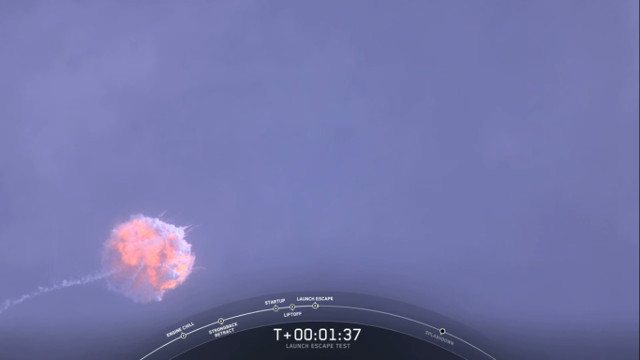
SpaceX has just completed the In-Flight Abort Test of one of its Crew Dragon spacecraft, the version of Dragon 2 produced for the transport of astronauts. A Falcon 9 rocket was deliberately blown up at the moment of maximum dynamic pressure, Max q in jargon, to test that the the systems which in a normal launch are used to rescue the crew aboard the Crew Dragon work properly.
The Crew Dragon spacecraft is equipped with four pairs of SuperDraco engines developed by SpaceX for its own spacecraft. According to plans, the Crew Dragon could also land on the mainland at the end of a mission using its SuperDraco engines to stop its fall but this possibility has been set aside, at least for now. Consequently, in the near future the SuperDraco engines will be used in the event of an emergency abort to push the Crew Dragon away from danger.
SpaceX carried out an abort test on May 6, 2015. The SuperDraco engines brought the Crew Dragon safely to the Atlantic Ocean proving that they worked smoothly. However, it was a short flight from a structure built in Cape Canaveral. Today’s test was performed in conditions that replicate those of a normal launch, with a Falcon 9 rocket.
This test was delayed by the accident that occurred on April 20, 2019, when a fuel leak from one of the SuperDraco engines during a test resulted in the destruction of the Crew Dragon. The cause of the leak was eliminated and a new test with a new spacecraft was successful in November.
The Falcon 9 rocket’s first stage was the one with the code B1046, on its fourth launch. SpaceX staff hoped to find a way to perform the In-Flight Abort Test in a way that would save the first stage but the stresses needed to verify that the systems work properly are so violent as to cause its destruction. The Falcon 9 rocket’s second stage was present but incomplete because it was needed only to replicate the conditions of a normal launch so it wasn’t used.

Everything seems to have gone well so the Crew Dragon spacecraft separated in time when the first stage of the Falcon 9 rocket was pushed into an anomalous situation that caused its voluntary destruction. After a few minutes the Crew Dragon splashed down off the coast of Cape Canaveral.
For today’s test, the recovery of the Crew Dragon is expected in about two hours. In a real emergency after a launch with a crew on board, a U.S. Air Force team would be ready to leave almost immediately to rescue the astronauts very quickly.
The Crew Dragon spacecraft will be examined and the test data will be analyzed to verify that everything went as planned. If the results are satisfactory for NASA, in the coming months SpaceX will proceed with a test manned mission to the International Space Station.



Permalink